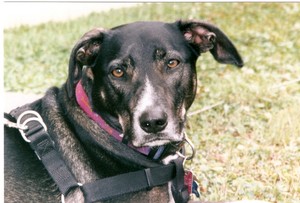The pancreas is a small organ shaped like a thin boomerang next to the stomach and small intestine. According to Nancy Kay, DVM, the pancreas releases enzymes necessary to help digest food. Pancreatitis, however, is when the pancreas becomes inflamed and produces too much enzymes. Just why a dog’s pancreas should do this is unknown, but diet and genetics are thought to play big parts. Some drugs such as sulpha drugs can sometimes inflame the pancreas as a side effect.
There are two basic types of canine pancreatitis — chronic and acute. As its name suggests, chronic pancreatitis symptoms are a constant problem for the dog. But in acute pancreatitis, the symptoms come on swiftly and are severe. Canine pancreatitis is potentially fatal. The big danger for a dog with pancreatitis is dehydration. If a dog’s skin is gently pulled and let go, it should immediately fall into place. If not, the dog is dehydrated and needs intravenous fluids immediately.
Major Symptoms
The main symptom of pancreatitis in dogs is vomiting more than four times in a 24 hour period. Eventually, they will just regurgitate bile or foam instead of food, but even this counts as vomiting. This also may be the first symptom owners notice. Diarrhea and/or a fever can accompany vomiting, but not always.
Dogs with acute pancreatitis attacks refuse food. Because of the nausea and vomiting, the dog will lose almost all of its appetite. The dog may also drool, gulp and constantly lick his or her lips when nauseated. Each dog has a slightly different way of displaying nausea, but these are the most common signs.
The dog will find it difficult to get comfortable and seem restless but will not want to play. The ears, head and tail will be lowered and the dog will seem to be cowering or frightened. The dog takes these strange body positions because of the extreme discomfort of nausea. The dog will also not want you to touch his or her belly.
Treatment
Treatment for acute pancreatitis must be done at a veterinarian’s. There are no reliable home remedies. Treatment is three pronged to keep the dog hydrated but to reduce pain and get the pancreas back to normal.
Food is withheld from the dog from one to three days, depending on how the dog is doing. In order to keep from getting dehydrated, the dog is hooked to an IV drip line in the foreleg. When the dog is allowed to eat, it’s low-calorie prescription dog food such as Science Diet I/D.
Dogs may be given fentanyl patches, injections or an IV of painkilling medication to make relaxation and sleep possible. The dog is sometimes put on a round of antibiotics, which often continues for days after the dog feels better and can go home. The dog’s blood will also be checked to be sure the pancreas is functioning normally.
In severe cases of acute pancreatitis, the dog may need a plasma transfusion. This is one of the reason why many veterinary practices keep large dogs like Labradors to act as blood or plasma donors.
Once a dog has recovered from an attack of pancreatitis that dog will be susceptible to another attack for the rest of his or her life. Keeping the dog on a sensible diet without any access to human junk food or the garbage can help prevent future attacks.
Additional References:
“The Veterinarian’s Guide to Your Dog’s Symptoms.” Michael S. Garvey, DVM; et al. Howell Book House; 2007.
Mar Vista Animal Medical Center. “Canine Pancreatitis.” http://www.marvistavet.com/html/body_canine_pancreatitis.html
Pet Place. “Acute Pancreatitis in Dogs.” Dr. Debra Primovic. http://www.petplace.com/dogs/acute-pancreatitis-in-dogs/page1.aspx
Author’s dog Pony was diagnosed with pancreatitis in 2007.
Reference:
- www.peteducation.com/article.cfm?c=2+1580&aid;=335
- www.vetinfo.com/dpancrea.html
- www.mscc.ca/pancreatitis.html
